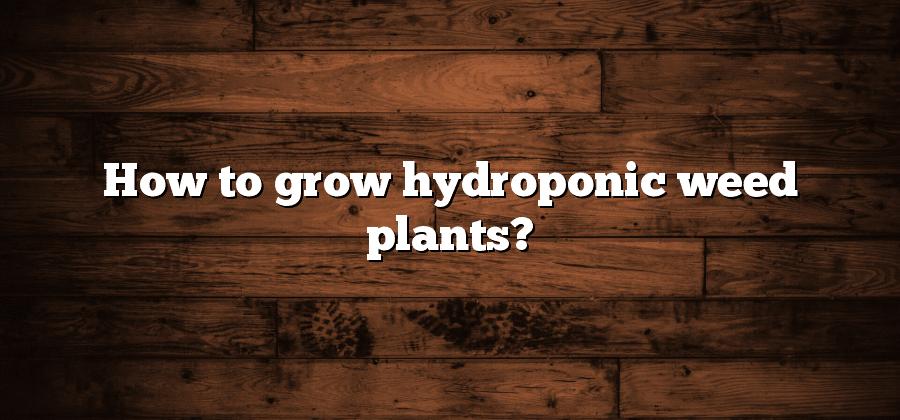Understanding Hydroponics: A Guide for Weed Cultivation
When it comes to growing weed using hydroponics, understanding the basics is crucial. Hydroponics is a method of cultivation that involves growing plants without soil, instead using water and a nutrient-rich solution. This technique allows for precise control over the growing environment, resulting in faster growth rates and higher yields. For weed cultivation, hydroponics offers several advantages, such as reducing the risk of pests and diseases, maximizing space utilization, and ensuring optimal nutrient uptake for healthy plant development.
One of the first steps in successfully growing hydroponic weed is selecting the right strain. Different strains have varying growth characteristics and requirements, so it is important to choose a strain that will thrive in a hydroponic system. Factors to consider include the strain’s ability to adapt to the controlled environment, its nutrient demands, and its yield potential. Researching and consulting experienced growers can help in selecting the appropriate strain for hydroponic cultivation.
Selecting the Right Strain for Hydroponic Growth
When it comes to selecting the right strain for hydroponic growth, there are several factors to consider. One of the most important aspects is the genetic makeup of the strain. Different strains have different characteristics, including growth patterns, yield potential, and potency levels. It is essential to research and choose a strain that aligns with your goals and preferences.
Another essential factor to consider is the availability of the strain. Some strains may be harder to find or may not be available in your location. It is crucial to source your seeds or clones from a reputable supplier to ensure the quality and authenticity of the strain. Additionally, consider the level of experience required to grow a particular strain successfully. Some strains are more beginner-friendly, while others may require more advanced knowledge and skills. Ultimately, selecting the right strain for hydroponic growth is a crucial decision that will greatly impact your cultivation journey.
Creating a Proper Hydroponic Setup for Marijuana Cultivation
When it comes to creating a proper hydroponic setup for marijuana cultivation, there are several key factors to consider. The first and most important element is selecting the appropriate hydroponic system for your needs. There are various types of hydroponic systems available, such as deep water culture, nutrient film technique, and ebb and flow, each with its own advantages and disadvantages. It’s crucial to research and understand the specific requirements of each system, taking into account factors like space availability, budget, and level of expertise.
In addition to choosing the right hydroponic system, another crucial aspect is ensuring proper ventilation and airflow within your setup. Marijuana plants require fresh air to thrive, as it assists in regulating temperature and humidity levels, prevents the build-up of pests and diseases, and promotes healthy growth. Installing proper ventilation equipment, such as fans or exhaust systems, can help maintain a stable and optimal growing environment. Proper airflow also helps in distributing essential nutrients and reducing the risk of mold and mildew formation.
Essential Nutrients and pH Balance in Hydroponic Weed Growing
Hydroponic cultivation for growing weed is a complex process that requires careful attention to detail. One crucial aspect of successfully cultivating marijuana hydroponically is providing the essential nutrients and maintaining the correct pH balance. Without the proper nutrients and pH levels, the plants can experience nutrient deficiencies or become more susceptible to diseases and pests. Therefore, it is vital for growers to understand the specific nutrient requirements and the importance of pH balance in hydroponic weed growing.
For hydroponic marijuana cultivation, plants rely heavily on nutrient solutions rather than soil for their nourishment. The nutrient solution needs to contain a balanced ratio of macronutrients (such as nitrogen, phosphorus, and potassium) and micronutrients (such as iron, manganese, and zinc). Each nutrient plays a crucial role in the growth and development of the plant and any deficiencies can lead to stunted growth and decreased yield. Additionally, maintaining the appropriate pH level is equally important as it affects the plant’s ability to absorb nutrients. A pH range of 5.5 to 6.5 is generally recommended for hydroponic weed cultivation, as it allows for optimal nutrient uptake and promotes healthy plant growth.
Providing Adequate Lighting for Hydroponic Cannabis Plants
When it comes to hydroponic cannabis plants, providing adequate lighting is crucial for their growth and development. Unlike outdoor cultivation, where plants receive natural sunlight, indoor hydroponic systems rely on artificial lighting sources to provide the necessary light energy. The right type of lighting is essential to ensure optimal photosynthesis, which is vital for the plant’s overall health and yield.
One of the most commonly used lighting options for hydroponic cannabis cultivation is LED (Light Emitting Diode) lights. LED lights have proven to be highly efficient and effective in providing the spectrum of light needed for the different stages of plant growth. They emit specific wavelengths that are easily absorbed by the plants, promoting healthy growth and high-quality yields. Additionally, LED lights have a longer lifespan compared to other lighting options and are more energy-efficient, making them a cost-effective choice for hydroponic cannabis cultivation.
Another popular lighting option for hydroponic cannabis plants is High-Intensity Discharge (HID) lights. HID lights, such as metal halide (MH) and high-pressure sodium (HPS) lights, have been used for decades in indoor horticulture. They produce a broad spectrum of light that closely mimics natural sunlight, promoting vigorous growth and robust flowering. However, HID lights tend to consume more energy and generate more heat than LED lights, requiring proper ventilation and cooling systems to prevent plant stress and overheating.
In conclusion, choosing the right type of lighting for your hydroponic cannabis plants is essential for their successful cultivation. Whether you opt for LED lights or HID lights, it is crucial to provide the right spectrum and intensity of light to ensure optimal photosynthesis and plant growth. Considering factors such as energy efficiency, lifespan, and heat generation will help you make an informed decision and create an ideal lighting setup for your hydroponic cannabis cultivation.






